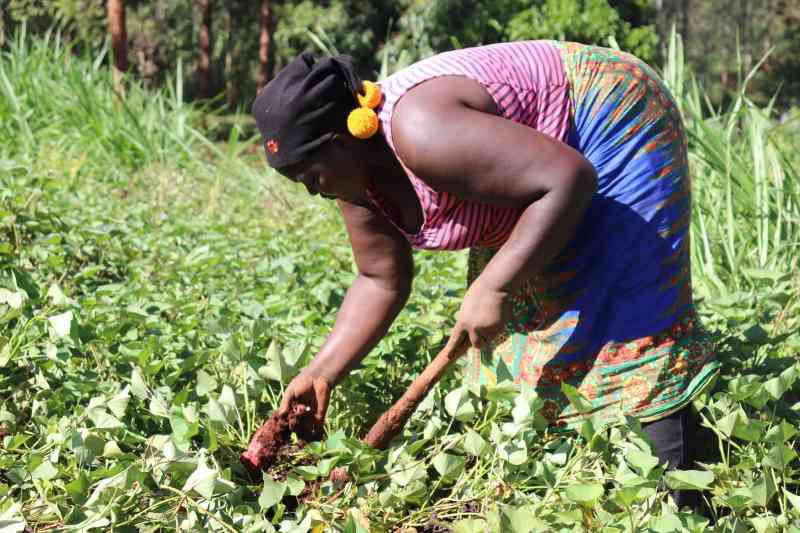
[Joseph Muchiri, Standard]
Nutritious foods like sweet potatoes are becoming more popular as Kenyans embrace healthy lifestyles. How about starting a sweet potato farm to ride on this craze? Well, sweet potatoes are easy to grow because they are hardy. Even with minimal fertilisation and care, they perform well. The fastest and easiest way to grow sweet potatoes is to use vines or cuttings.
To start off, using a sharp knife, cut a piece of a runner, about 30cm long. Remove all the leaves except for the tiny ones at the very tip. Plant the cutting by covering the whole length with soil, only the leaves of the tip should stick out of the ground. The cuttings will root at every leaf node.
Best soils
Sweet potato also grows roots from every leaf node that develops as your cutting grows. In the absence of cuttings, sweet potatoes can be planted from slips or vines. You can create your own slips by slicing a sweet potato in half lengthwise and placing it on a bed of damp potting soil. Cover the pieces with a few inches of soil and keep them moist and warm. Small roots should develop within a few days, followed by leaves. Plant your sweet potatoes in full sun to partial shade.
The best soil for growing sweet potatoes is sandy, but they can be grown in wide range of soils. For good results, grow the potatoes on raised ridges or mounds. Raised beds improves the drainage and gives the tubers a nice deep soil to develop in. Planting on flat surface could result in small, bent and forked sweet potatoes. Add compost manure to supply nutrients.
No nitrogenous fertilisers
Avoid nitrogenous fertilisers as they promote growth of leaves at the expense of the tubers. Place the runners transversely across the ridge 30cm to 40cm apart. A stick with a notch at the end is used to secure the runner, which is then pushed into the soil from the top of the ridge until the two ends protrude above the soil. You can also push in the runner from the broken stem end, leaving more of the runner above ground. However, this means more of the runner will dry out before rooting and there's a smaller area to develop roots. To prevent this, keep the surface of the soil moist by frequent and light irrigation.
Mulch the vines two weeks after planting to smother weeds, conserve moisture, and keep the soil loose for root development. Occasionally, lift longer vines to keep them from rooting at the joints, or they will put their energy into forming many undersised tubers at each rooted area rather than ripening the main crop at the base of the plant. Handle plants as little as possible to prevent wounds that are vulnerable disease spores. If the weather is dry, irrigate the crop until two weeks before harvesting, then let the soil dry out a bit. Don't overwater, or the plants as it may cause rotting.
Footrot
Watch out for sweet potato weevils which make holes in the stems and tubers to lay their eggs. The immature pest feeds on the fleshy roots while the adults feed attack the vines and leaves. The pest also spread foot rot, which creates enlarging brown to black areas on stems near the soil and at stem ends. The weevils could be hard to control once they attack because they multiply quickly.
Crop rotation
The use of certified planting material is a sure way of controlling the weevils. Crop rotation is also another way to control the weevils. Practice a four-year crop rotation. In case of heavy attack by pests, destroy infected plants and their roots, or place in sealed containers and dispose of them.
Fungal diseases are the most common in potato production. The most common is black rot, which results in circular, dark depressions on tubers. To control the disease, discard infected potatoes, and cure the undamaged roots from the same crop carefully. Don't confuse this disease with less-serious scurf, which creates small, round, dark spots on tuber surfaces but doesn't affect eating quality. Harvest the crop as soon as the leaves start turning yellow.
[The writer is an expert on agricultural solutions and sustainable agriculture]

